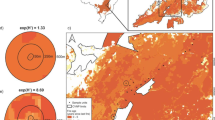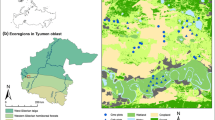Abstract
A “space-for-time substitution” was used to analyse how the communities of Spheciformes wasps varied in different diversity parameters for a period of 15 years after a summer wildfire in a Mediterranean agroecosystem (Arribes del Duero, western Spain), employing Malaise traps and yellow pan traps to sample the communities. Both the habitat and the particular environmental conditions marking the interannual population variations in Spheciformes communities exert an important influence on the resultant assemblage, although the time after the wildfire was the most important factor in the recovery of species H′ diversity and evenness after the disturbance. Fire caused a drop of diversity and evenness values. Nevertheless, evenness recovered continuously, while H′ diversity continued to decrease until experiencing a recovery as from the fourth-fifth year post-fire. The effect of the time after the wildfire on abundance (N) or richness (S) values was not significant.



Similar content being viewed by others
References
Breece CR, Kolb TE, Dickson BG et al (2008) Prescribed fire effects on bark beetle activity and tree mortality in southwestern ponderosa pine forests. Forest Ecol Manag 255:119–128
Campbell JW, Hannula JL, Waldrop TA (2007) Effects of prescribed fire and fire surrogates on floral visiting insects of the blue ridge province in North Carolina. Biol Conserv 134:393–494
Cane JH, Neff JL (2011) Predicted fates of ground-nesting bees in soil heated by wildfire: thermal tolerances of life stages and a survey of nesting depths. Biol Conserv 144:2631–2636
Chambers BQ, Samways MJ (1998) Grasshopper response to a 40-year experimental burning and mowing regime, with recommendations for invertebrate conservation management. Biodivers Conserv 7:985–1012
Cruz-Sánchez MA, Asís JD, Gayubo SF et al (2011) The effects of wildfire on Spheciformes wasp community structure: the importance of local habitat conditions. J Insect Conserv 15:487–503
Fernández MM, Salgado JM (2004) Recolonization of a burn pine forest (Pinus pinaster) by Carabidae (Coleoptera). Eur J Soil Biol 40:47–53
Force DC (1981) Post-fire insect succession in Southern California chaparral. Am Nat 117:575–582
Gibb H, Hjältén J (2007) Effects of low severity burning after clear-cutting on mid-boreal ant communities in the 2 years after fire. J Insect Conserv 11:169–175
González JA, Gayubo SF, Asís JD et al (2009) Diversity and biogeographical significance of solitary wasps (Chrysididae, Eumeninae and Spheciformes) at the Arribes del Duero Natural Park, Spain: their importance for insects diversity conservation in the Mediterranean region. Environ Entomol 38:608–626
Harmon JP, Hladilek EE, Hinton JL et al (2003) Herbivore response to vegetational diversity: spatial interaction of resources and natural enemies. Popul Ecol 45:75–81
Hirowatari T, Makihara H, Sugiarto (2007) Effects of fires on butterfly assemblages in lowland dipterocarp forest in East Kalimantan. Entomol Sci 10:113–127
Hoffmann BD (2003) Responses of ant communities to experimental fire regimes on rangelands in the Victoria River District of the Northern Territory. Austral Ecol 28:182–195
Knight TM, Holt RD (2005) Fire generates spatial gradients in herbivory: an example from a Florida sandhill ecosystem. Ecology 86:587–593
LaSalle J, Gauld ID (eds) (1993) Hymenoptera and biodiversity. CAB International, The Natural History Museum, Wallingford
Magurran AE (2004) Measuring biological diversity. Blackwell Science Publishing, Oxford
Moreno JM, Vázquez A, Vélez R (1998) Recent history of forest fires in Spain. In: Moreno JM (ed) Large fires. Backhuys Publishers, Leiden
Moretti M, Zanini M, Conedera M (2002) Faunistic and floristic post-fire succession in southern Switzerland: an integrated analysis with regard to fire frequency and time since the last fire. In: Wiegas DX (ed) Forest fire research and wildland fire safety. Millpress, Rotterdam. CD-Rom
Moretti M, Obrist MK, Duelli P (2004) Arthropod biodiversity after forest fires: winners and losers in the winter fire regime of the Southern Alps. Ecography 27:173–186
Moretti M, Duelli P, Obrist MK (2006) Biodiversity and resilience of arthropod communities after fire disturbance in temperate forests. Oecologia 149:312–327
Niwa CG, Peck RW (2002) Influence of prescribed fire on carabid beetle (Carabidae) and spider (Araneae) assemblages in forest litter in southwestern Oregon. Environ Entomol 31:785–796
Nunes L, Leather S, Rego F (2000) Effects of fire on insects and other invertebrates: a review with particular reference to fire indicator species. Silva Lusitana 8(1):15–32
Panzer R (2003) Importance of in situ survival, recolonization, and habitat gaps in the postfire recovery of fire-sensitive prairie insects species. Nat Area J 23:14–21
Parr CL, Robertson HG, Biggs HC et al (2004) Response of African savanna ants to long-term fire regimes. J Appl Ecol 41:630–642
Picket STA (1989) Space for time substitution as an alternative for long studies. In: Likens EG (ed) Long-term studies in ecology: approaches and alternatives. Springer, Berlin, pp 112–135
Potts SG, Vulliamy B, Dafni A et al (2003) Response of plant-pollinator communities to fire: changes in diversity, abundance and floral reward structure. Oikos 101:103–112
Potts SG, Vulliamy B, Roberts S et al (2005) Role of nesting resources in organising diverse bee communities in a Mediterranean landscape. Ecol Entomol 30:78–85
Silveira JM, Barlow J, Andrade RB et al (2013) The responses of leaf litter ant communities to wildfires in the Brazilian Amazon: a multi-region assessment. Biodivers Conserv 22:513–529
Steffan-Dewenter I (2002) Landscape context affects trap-nesting bees, wasp, and their natural enemies. Ecol Entomol 27:631–637
Stein JS, Price PW, Abrahmson WG et al (1992) The effect of fire on stimulating willow regrowth and subsequent attack by grasshoppers and elk. Oikos 65:190–196
Swengel AB (2001) A literature review of insect responses to fire, compared to other conservation managements of open habitat. Biodivers Conserv 10:1141–1169
Taki H, Viana BF, Kevan PG et al (2008) Does forest loss affect the communities of trap-nesting wasps (Hymenoptera: Aculeata) in forests? Landscape versus local habitat conditions. J Insect Conserv 12:15–21
Trabaud L, Prodon R (1993) Fire in Mediterranean ecosystems. ECSC-EEC-EAEC, Brussels-Luxembourg, p 333
Whelan RJ (1995) The ecology of fire. Cambridge University Press, Cambridge
York A (1994) Long-term effects of fuel reduction burning on invertebrates in a dry sclerophyll forest. In: Proceedings of the conference held 8–9 October 1994. Biodiversity and fire: the effects and effectiveness of fire management. Footscray, Melbourne. Biodiversity series, Paper No. 8. Biodiversity Unit. Department of the Environment, Sport and Territories, 1996
Acknowledgments
This study was funded through a collaborative agreement between the Environmental Agency of the Regional Government of Castile and Leon and the University of Salamanca for the analysis of the diversity of the entomological fauna in the network of Natural Spaces in Castile and Leon, by means of bioindicator wasps.
Author information
Authors and Affiliations
Corresponding author
Rights and permissions
About this article
Cite this article
Cruz-Sánchez, M.A., Asís, J.D., González, J.A. et al. Wildfires: its influence on the diversity parameters of predatory-insect communities in a Mediterranean agroecosystem of European interest. J Insect Conserv 18, 903–908 (2014). https://doi.org/10.1007/s10841-014-9698-5
Received:
Accepted:
Published:
Issue Date:
DOI: https://doi.org/10.1007/s10841-014-9698-5




